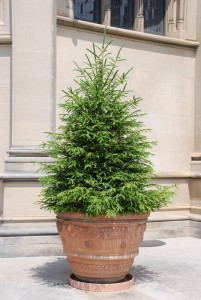Fall slowdown in the garden brings many of us back indoors to prepare for the winter holidays ahead. A number of serious canker diseases attack evergreens in the fall and winter if soil moisture is not plentiful. These diseases include botryosphaeria, cytospora, phomopsis, and seiridium cankers. Each organism is capable of causing branch dieback or death to the entire shrub or tree.
Evergreens such as laurels, rhododendrons, spruces, Leyland cypress, upright junipers, and arborvitae are the most susceptible. In late fall, around Thanksgiving, deep watering of evergreens in the ground is generally good insurance against disease. Weekly watering entails supplying 1 inch of natural precipitation (rain or snowfall equivalent) and/or irrigation.
A gardener should be aware of the natural environment. In particular, needle conifers in containers may be in most jeopardy of the winter weather ahead. Wintry winds may desiccate needles rapidly. An evergreen’s umbrella-like branch canopy reduces the amount of rain and snowfall that reaches the root mass in the container.
Containerized evergreens in the Southern Appalachian region (USDA zones 6 and 7) should be watered every 8-10 days over the winter months. Container media may freeze solid for a few days during winter cold snaps, but the media thaws out and the plant re-hydrates. A fully hydrated plant is better able to cope in frozen media than one in drycontainer media.
Evergreens should be transplanted into larger containers and fresh media every 2 to 3 years.
Credit: Information supplied by Dr. Alan S. Windham, Extension Plant Pathologist, University of Tennessee, Plant Diagnostic Lab, Nashville


 Posted in
Posted in 

Thanks for the reminder to water the evergreens. And I have a small false cypress in a ‘small’ container. Guess I’d better drop it into a larger container before we get a deep freeze. Thanks for the info.